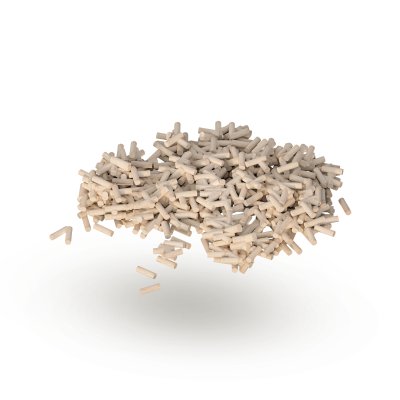 |
Pellets
The complex development of the enterprise is impossible without the organization of a waste processing system. Sawdust from cutting wood on sawmills is not only used as fuel for boilers, but also processed into pellets. Pellets are a biofuel obtained from sawmill wood waste. Represents cylindrical granules of the standard size.
Part number:
Supplier:
LLC "Luzales"Description
In 2017, Luzales LLC established its own pellet production.
The raw materials for production are wood waste: sawdust and wood chips. The raw material enters the crusher, where it is crushed to the state of flour. The resulting mass enters the dryer, from it - into the press granulator, where the wood flour is compressed into granules. Compression during pressing raises the temperature of the material. The lignin contained in the wood softens and sticks the particles together into dense cylinders. The production of one ton of pellets takes 4-5 cubic meters of wood waste. Finished granules are cooled, packed in a standard package of 12-50 kg.
The productivity of the new line is 5 tons of pellets per hour, which allows, with a two-shift organization of labor, to process up to 100 thousand cubic meters of sawmill waste during the year and ensure the production of up to 30 thousand tons of finished products.
Pellets are environmentally friendly fuel with an ash content of no more than 3%. Granules are less prone to self-ignition, as they do not contain dust and spores. Because of this, they do not cause an allergic reaction in humans.
Granules differ from ordinary wood in high dryness (humidity is only 8-10%, and the moisture content of firewood can be from 8 to 60%) and greater (about one and a half to two times) density than firewood. These qualities provide a high calorific value compared to chips or firewood: when burning a ton of pellets, from 4.3 to 6.0 thousand kilocalories of heat are released, which is one and a half times more than conventional firewood.
The raw materials for production are wood waste: sawdust and wood chips. The raw material enters the crusher, where it is crushed to the state of flour. The resulting mass enters the dryer, from it - into the press granulator, where the wood flour is compressed into granules. Compression during pressing raises the temperature of the material. The lignin contained in the wood softens and sticks the particles together into dense cylinders. The production of one ton of pellets takes 4-5 cubic meters of wood waste. Finished granules are cooled, packed in a standard package of 12-50 kg.
The productivity of the new line is 5 tons of pellets per hour, which allows, with a two-shift organization of labor, to process up to 100 thousand cubic meters of sawmill waste during the year and ensure the production of up to 30 thousand tons of finished products.
Pellets are environmentally friendly fuel with an ash content of no more than 3%. Granules are less prone to self-ignition, as they do not contain dust and spores. Because of this, they do not cause an allergic reaction in humans.
Granules differ from ordinary wood in high dryness (humidity is only 8-10%, and the moisture content of firewood can be from 8 to 60%) and greater (about one and a half to two times) density than firewood. These qualities provide a high calorific value compared to chips or firewood: when burning a ton of pellets, from 4.3 to 6.0 thousand kilocalories of heat are released, which is one and a half times more than conventional firewood.